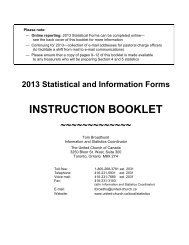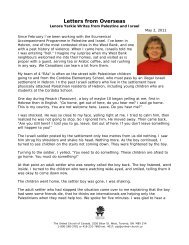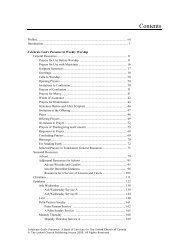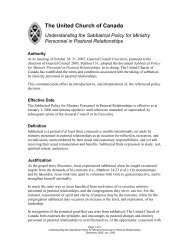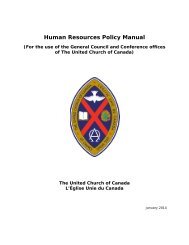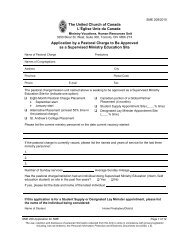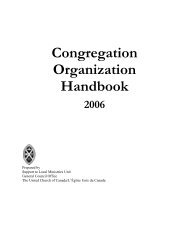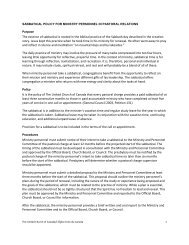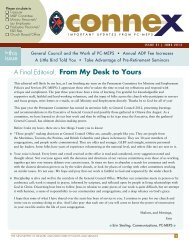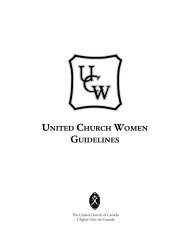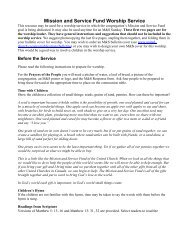Guidelines for Transition Teams - The United Church of Canada
Guidelines for Transition Teams - The United Church of Canada
Guidelines for Transition Teams - The United Church of Canada
Create successful ePaper yourself
Turn your PDF publications into a flip-book with our unique Google optimized e-Paper software.
Appendix 4: Developing the Interim Minister’s<br />
Position Description<br />
At the time <strong>of</strong> the appointment, the <strong>Transition</strong> Team, the new Interim Minister, the presbytery, and<br />
the Conference fill out the Record <strong>of</strong> Appointment <strong>for</strong>m (MEPS 433 AP).<br />
Page 5 <strong>of</strong> that <strong>for</strong>m relates to the special terms <strong>of</strong> Interim Ministry appointments and requires a<br />
statement <strong>of</strong> the preliminary goals <strong>of</strong> the Interim Ministry. <strong>The</strong>se can be two or three broadly stated<br />
reasons <strong>for</strong> the interim, such as these:<br />
• to lead the congregation in a process <strong>of</strong> healing and reconciliation after a time <strong>of</strong> conflict<br />
• to lead the congregation in redeveloping its vision <strong>of</strong> mission and ministry<br />
• to lead the congregation in revitalizing its mission after a long pastorate<br />
<strong>The</strong> preliminary goals <strong>for</strong>m the core <strong>of</strong> the position description, and later, as the <strong>Transition</strong> Team and<br />
the Interim Minister work together, are developed into specific goals and action plans.<br />
Besides working on these broad goals, the congregation will expect the Interim Minister to do the<br />
“usual work” <strong>of</strong> a minister. One <strong>of</strong> the tough realities is sorting out the duties, bearing in mind that<br />
the interim work takes real time and must take priority <strong>for</strong> the duration <strong>of</strong> the interim appointment.<br />
<strong>The</strong> position description needs to reflect this difficult juggling act. It is important to help the<br />
congregation understand that some <strong>of</strong> the “usual work” will have to be done by someone else, done<br />
to a lesser extent, or deferred. Interim Ministry cannot simply be added to an already full pastoral<br />
schedule. <strong>The</strong> other distinctive thing about the position description in Interim Ministry is that it will<br />
change during the course <strong>of</strong> the interim period as the focus shifts from one goal to another. It helps<br />
the congregation (not to mention the Interim Minister) if these changes are handled transparently, so<br />
that people begin to learn that ministry has different needs at different times.<br />
<strong>The</strong> “Ideal” Week<br />
A useful way <strong>of</strong> laying out the position description is by describing an “ideal” week. Real weeks are<br />
never ideal, <strong>of</strong> course, but the ideal gives a good basis <strong>for</strong> accountability. A minister’s work week is<br />
40 hours. It includes worship, administration, pastoral care, and Christian education. <strong>The</strong> Interim<br />
Ministry part <strong>of</strong> the job involves time <strong>for</strong> working with the <strong>Transition</strong> Team, research and data<br />
gathering, planning special events, writing reports, and so on.<br />
<strong>Guidelines</strong> <strong>for</strong> <strong>Transition</strong> <strong>Teams</strong> 43



